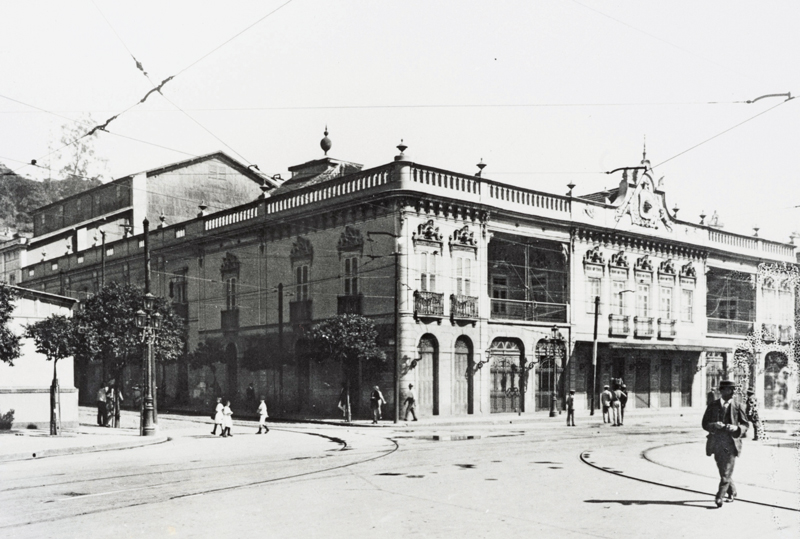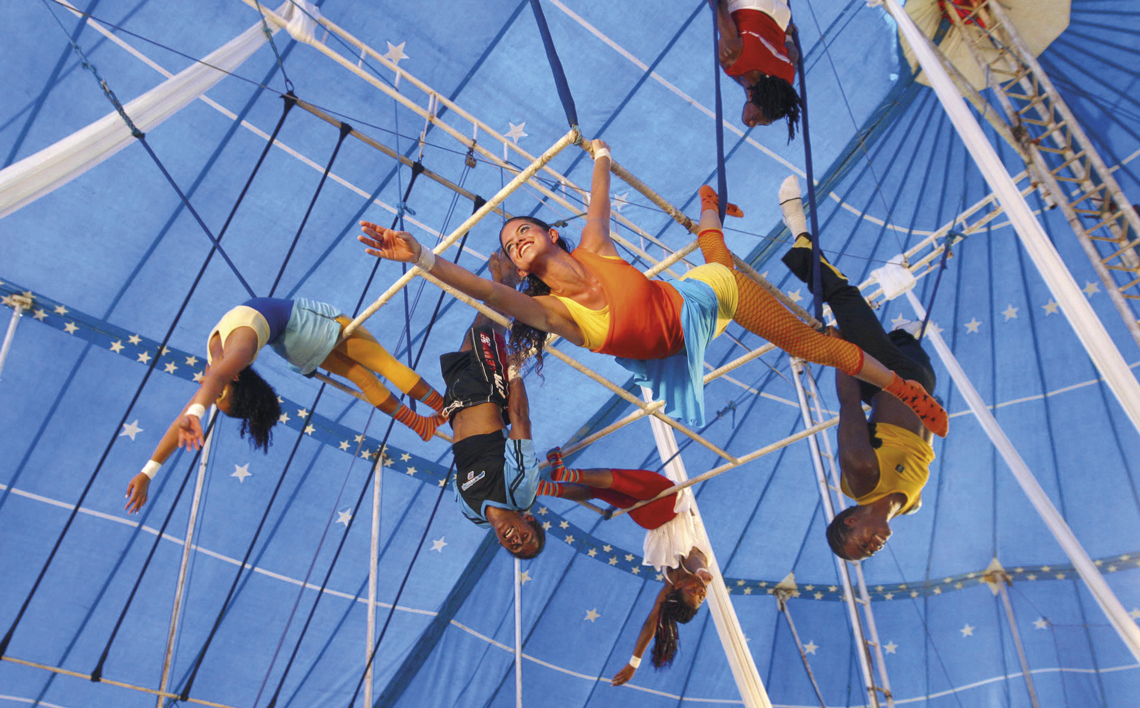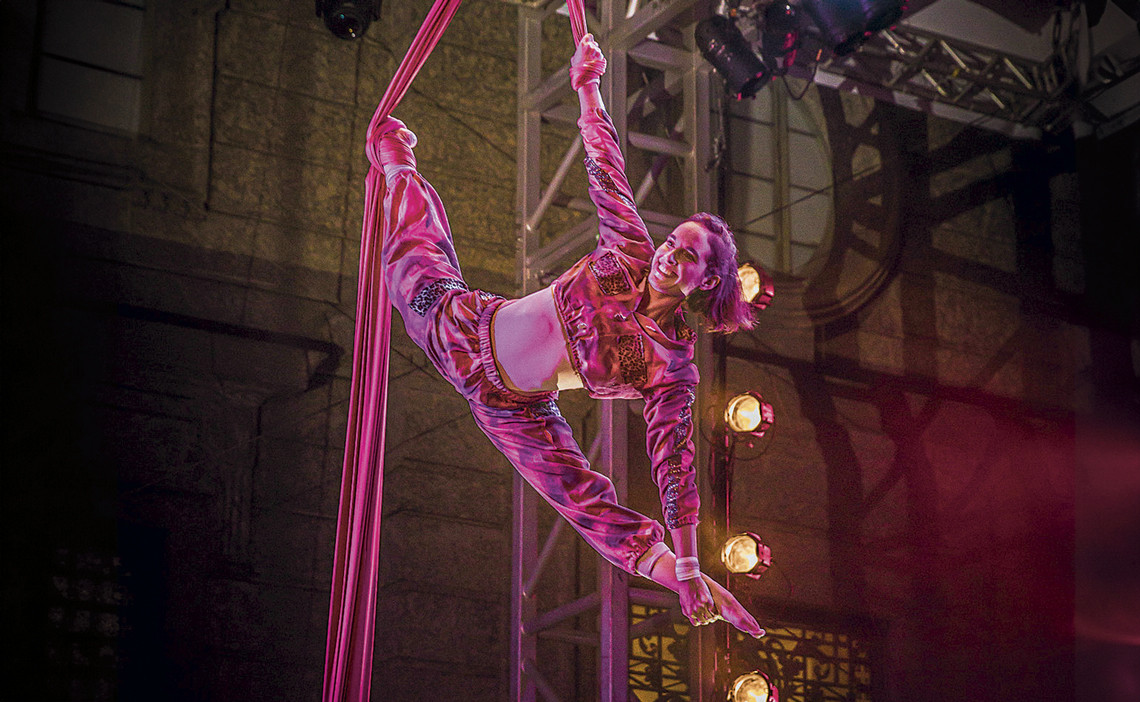When Mademoiselle Gigi’s name was announced under the big top, dozens of pigeons would enter the circus ring, stealing the limelight and obeying her commands. Dressed in a voluminous dress, inspired by the costumes of the Queen of France, Maria Antoinette (1755–1793), the “queen of the pigeons” was capable of making the birds move miniature devices such as a Ferris wheel, seesaw, and carousel. The act, which ended with a grand finale in which the pigeons landed on the artist’s body, gained prominence in Brazilian circuses until the end of the 1970s, a period when the presence of animals was still accepted in the circus ring. Although there is still no federal law regarding animals, the practice is today prohibited in some Brazilian states, such as Rio de Janeiro and Goiás, similar to what happens in other countries.
Besides training pigeons, Gê Pimenta (1943–2015), the artist responsible for the attraction, worked as a musician and illusionist in traveling circus companies between the 1960s and 1970s—in acts such as the sword box and metamorphosis. She also sold candy during the interval at the shows and took part in administrative decisions related to the business. Today, she is one of the research subjects of Daniele Pimenta, a professor at the Institute of Arts of the Federal University of Uberlândia (UFU). With a background as a ballet dancer and the daughter of Gê, Daniele did a postdoctoral fellowship at São Paulo State University (UNESP) in 2022, about the history of women from her family who had careers in the circus. “While women in society generally faced opposition from parents and husbands to gain the right to ‘work outside the home,’ circus performers have always worked, as well as raising families. In this aspect, a woman was more emancipated in the circus,” defends Daniele Pimenta.
The pigeon trainer’s career path is part of a more widespread mapping, of a historic and analytical nature, of the women who worked in traveling circuses in Brazil from the end of the nineteenth century until the 1970s. The survey is carried out by the research group O Circo e o Riso (meaning circus and laughter), of the UNESP Institute of Arts, São Paulo campus, coordinated by Mario Fernando Bolgnesi, a retired professor from the same institution and Daniele Pimenta’s research supervisor, and also by Eliene Benicio Amancio Costa, of the School of Theater of the Federal University of Bahia (UFBA). Founded in 1997, the collective currently has 27 members.

Augusto Malta / Moreira Salles Institute CollectionThe front of the Teatro Lírico (c. 1928), originally the Circo Olímpico da Guarda Velha, in the center of RioAugusto Malta / Moreira Salles Institute Collection
Another subject of the group’s research is the phenomenon of the rumbeiras in the Northeast of Brazil, which is the topic of the master’s dissertation currently underway by sociologist Lívia Souza Mattos, at UNESP. They are dancers who perform a circus act that has been very popular among audiences from that region of Brazil since the first half of the twentieth century. “Besides dancing, they usually sing different Latin musical genres: not just rumba, but also mambo, samba, and baião, for example. They have become more successful than clowns, trapeze artists, and jugglers,” says Bolognesi. “In this case, the research by Mattos seeks to discuss issues such as the objectification of the female body in the circus ring.”
In Brazil, scientific research about the circus has been advancing, despite there not being a specific higher education course in the area—unlike in countries such as Canada, France, England, Australia, Sweden, Argentina, and Mexico. In Brazil, due to the lack of undergraduate circus courses, subjects related to circus arts are gaining space on the curriculum of other courses, such as performing arts and physical education. “The circus has been present in the country since the beginning of the nineteenth century and around 500 companies tour Brazil today, both in small municipalities in the Amazon as well as in the large capitals such as Rio and São Paulo,” says Marco Antonio Coelho Bortoleto, a faculty member of the School of Physical Education of the University of Campinas (UNICAMP) and coordinator of the Circus Study and Research Group (CIRCUS), based in the same institution. “However, circus has not yet managed to enter the undergraduate program, unlike dance and theater.”
Created in 2006, the collective was also led by historian Erminia Silva, who was a professor on the Graduate Program in Arts at UNESP and died on March 13 this year. Among other activities, the group develops surveys and events about circus arts such as the International Circus Seminar, the fifth edition of which is planned for December. There is also the podcast PodeCircus, launched in 2020, which regularly presents interviews with researchers linked to the circus, as well as the results of their academic studies.

Personal Collection / Daniele PimentaArtist Gê Pimenta as Mademoiselle GigiPersonal Collection / Daniele Pimenta
One of them is the PhD thesis of performing artist Lua Barreto, defended in 2022 in the School of Physical Education of UNICAMP. The study surveyed around 300 circus-training institutions and spaces that operate in Brazil today. According to the researcher, the number shows the growth of this type of initiative in the country, especially in the last decade. “One of the oldest of the genre is the National School of Circus, which offers technical courses accredited by the MEC [Ministry of Education] and was opened in 1982, in Rio de Janeiro. Prior to this, in order to become a circus artist, a person had to be born into a circus family or, as the saying goes, run away with a traveling circus,” says Barreto, who today lectures in the School of the Future in Arts Basileu França, in Goiânia (State of Goiás), which offers technical training in the area for high school–level students.
According to Bortoleto, the amount of graduate research on the topic is also growing in Brazil. The catalog of theses and dissertations of the Brazilian Federal Agency for Support and Evaluation of Graduate Education (CAPES) records around 201 academic studies related to the topic carried out in Brazilian universities since the 1980s, with 189 of them being defended between the 2000s and 2020s. “Today, Brazil is a reference in Latin America for the production of scientific knowledge about the circus and it does this in several dimensions, such as historical, pedagogical, and aesthetic,” states the researcher.
Bortoleto also considers that due to the lack of specialized journals in the country, scientific literature about the theme produced in Brazil can be found in performing arts periodicals, but also in other areas of knowledge, such as physical education itself and even medicine. Last year, Urdimento – Revista de Estudos em Artes Cênicas, of Santa Catarina State University (UDESC), dedicated two dossiers to the topic. In 2020, it was the turn of the journal Repertório, from the graduate program in performing arts of UFBA, to do the same.
Overseas, the need to concentrate cutting-edge research about the circus in a single periodical gave rise to Circus: Arts, Life and Sciences (CALS), the first international scientific journal with this focus. Launched in 2020 by the Circus Arts Research Platform (CARP), an international research platform which UNICAMP is part of, the title has a digital format and is published with funding from the University of Michigan, in the USA. Published annually, it reaches its third issue in May, bringing together articles in French and English.

Xando PereiraStudents from the Picolino School of Circus Arts, in Salvador: institution seeks to promote social inclusion with workshops on circus techniquesXando Pereira
The last edition, which came out in 2023, included a review of the book Um Brasil de circos: A produção da linguagem circense do século XIX aos anos de 1930 (A Brazil of circuses: The production of circus language from the 1800s to the 1930s; Circonteúdo, 2022) written by Erminia Silva and by historian Daniel de Carvalho Lopes, an independent researcher with a PhD in education from USP and a member of CIRCUS-UNICAMP. The work maps 42 companies operating in the state of Rio de Janeiro between the 1810s and 1930s. Among them, is the Circo Olímpico da Guarda Velha, created in the 1850s by artist and businessman Bartholomeu Corrêa da Silva (1828–1917), which was established in the center of Rio de Janeiro at the time. There, Silva began to build a stable circus, from masonry, with the capacity for over 2,000 people, which also received theater productions. In 1869, the space had already taken the form of a building and gained several names before being called the Teatro Lírico, in 1890. The establishment was run by the businessman until 1913 and the construction ended up being demolished in the 1930s, when the land became a parking lot. “The expectation is that the journal CALS helps Brazilian researchers to publish their articles,” informs Bortoleto, who is a member of the periodical’s scientific committee.
Daniele Pimenta, of UFA, defends that, thanks to the work of researchers dedicated to the circus, “the historical prejudice of universities towards the subject” has been decreasing. Proof of this, according to her, was the creation in 2015 of the Circo e Comicidade (meaning circus and comedy) working group, at the Brazilian Association of Research and Graduate Studies in Performing Arts (ABRACE). “Revue faced the same prejudice as circus in academic circles, as did popular comedy,” says Pimenta.
“The circus can provide contributions to pedagogical, social, and artistic fields,” writes Fabio Dal Gallo, a teacher at the School of Theater at UFBA, in an article in the book A arte do circo na América do Sul: Trajetórias, tradições e inovações na arena contemporânea (The art of circus in South America: Trajectories, traditions, and innovations in the contemporary arena; Edições Sesc, 2023), organized by anthropologist Julieta Infantino, of the University of Buenos Aires. In the text, the researcher discusses social circus, a concept that arose in Latin America in the 1990s through nongovernmental organizations and had global repercussions. Born in Italy, Dal Gallo has been studying the subject since 2003. That year, he started researching for his master’s in his homeland, at the University of Bologna, and continued the investigation in his PhD, defended in 2009, at UFBA.
The thesis led to the book Escola Picolino: O circo social e a arte-educação (Picolino school: Social circus and art education; Editora Perspectiva, 2018). In the work, Dal Gallo analyzes the work of the Picolino School of Circus Arts, founded in 1985 in Salvador (Bahia) by artists Anselmo Serrat (1948–2020) and Verônica Tamaoki. The institution was one of the first in Brazil to use circus techniques to promote the social inclusion of young people in situations of vulnerability. “The actions of social circus are guided by the concept of art-education and, in general, have pedagogical support so that these young people do not give up on formal education, for example,” explains the researcher, stressing that Brazil is a benchmark for this type of proposal. “Despite working in a parallel circuit, social circus also interacts with the commercial circuit. It improved so much in the country that two students from Picolino ended up working in Cirque du Soleil,” he adds.
Republish